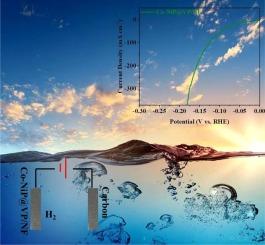Efficient hydrogen evolution reaction in alkaline seawater and urea using flower-like Co-NiP@VP/NF electrocatalyst
IF 6.7
1区 工程技术
Q2 ENERGY & FUELS
引用次数: 0
Abstract
With the depletion of global energy, increasingly severe environmental problems and the pursuit of renewable energy and clean energy, electrocatalytic water splitting has become well-known as an efficient, stable and simple method of hydrogen production. In this paper, M−NiP@VP/NF (M=Co, Mo and Cr) composites were synthesized on nickel foam with low cost, abundant reserves, high conductivity and supportive properties by simple hydrothermal and phosphating methods. Among them, Co-NiP@VP/NF has excellent electrochemical catalytic activity for hydrogen evolution reaction (HER) in seawater electrolyte containing 1.0 M KOH and urea solution containing 1.0 M KOH due to its abundant active sites, dense nanoflower-like structures and accelerated electron transfer rate. The material has a very rich nanoflower-like structure that exposes many contact areas and provides active sites, which also provides the basis for its superior catalytic properties. Notably, the Co-NiP@VP/NF catalyst present overpotential of only 164 mV at 100 mA cm−2 in 1.0 M KOH + seawater electrolyte solution and has the lowest Tafel slope (65.41 mV dec-1) for HER. In addition, we also carried out a durability measurement for 15 h, and the result showed a sharp decline at first and then relatively stable. Finally, we also compared the study with other literature, and the catalytic activity of this catalyst is much better than that of most other catalysts. This paper provides a reasonable synthesis method with excellent performance, which provides a possibility for the subsequent extensive application and popularization of seawater.

使用花状 Co-NiP@VP/NF 电催化剂在碱性海水和尿素中进行高效氢进化反应
随着全球能源的日益枯竭、环境问题的日益严峻以及人们对可再生能源和清洁能源的追求,电催化水分离作为一种高效、稳定、简单的制氢方法已广为人知。本文通过简单的水热法和磷化法,在泡沫镍上合成了具有低成本、储量丰富、高导电性和支持性的 M-NiP@VP/NF (M=Co、Mo 和 Cr)复合材料。其中,Co-NiP@VP/NF 在含 1.0 M KOH 的海水电解液和含 1.0 M KOH 的尿素溶液中,因其丰富的活性位点、致密的纳米花状结构和加速的电子传递速率,对氢进化反应(HER)具有优异的电化学催化活性。该材料具有非常丰富的纳米花状结构,暴露出许多接触区域并提供了活性位点,这也为其卓越的催化性能奠定了基础。值得注意的是,在 1.0 M KOH + 海水电解质溶液中,Co-NiP@VP/NF 催化剂在 100 mA cm-2 时的过电位仅为 164 mV,并且具有最低的 HER 塔菲尔斜率(65.41 mV dec-1)。此外,我们还进行了 15 小时的耐久性测量,结果显示起初会急剧下降,然后相对稳定。最后,我们还将研究结果与其他文献进行了比较,发现该催化剂的催化活性远远优于其他大多数催化剂。本文提供了一种性能优良的合理合成方法,为后续海水的广泛应用和推广提供了可能。
本文章由计算机程序翻译,如有差异,请以英文原文为准。
求助全文
约1分钟内获得全文
求助全文
来源期刊

Fuel
工程技术-工程:化工
CiteScore
12.80
自引率
20.30%
发文量
3506
审稿时长
64 days
期刊介绍:
The exploration of energy sources remains a critical matter of study. For the past nine decades, fuel has consistently held the forefront in primary research efforts within the field of energy science. This area of investigation encompasses a wide range of subjects, with a particular emphasis on emerging concerns like environmental factors and pollution.
 求助内容:
求助内容: 应助结果提醒方式:
应助结果提醒方式:


